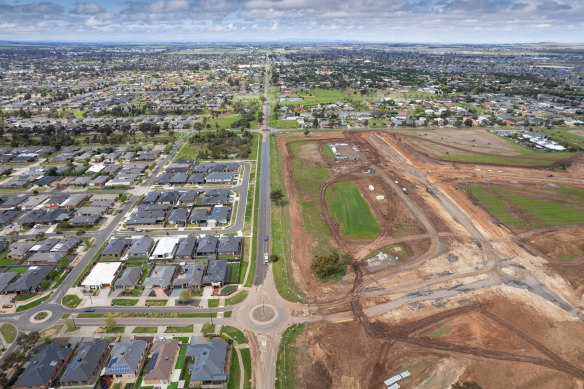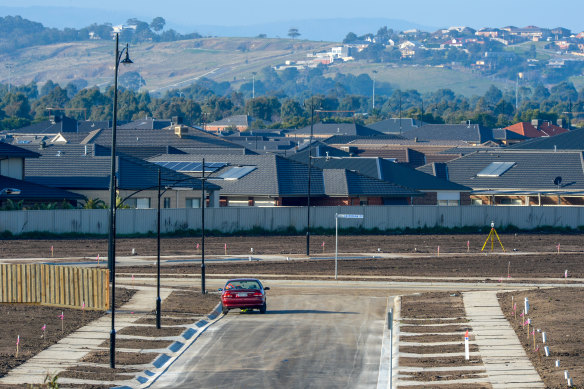This was published 9 months ago
The six new places you’ll be able to build a home in Melbourne
By Adam Carey and Broede Carmody
Farmland on Melbourne’s fringe will be developed into 180,000 new homes and more than a dozen industrial estates over the next decade.
The Allan government has responded to pleas from the property sector to release its plan for Melbourne’s last undeveloped greenfields sites, which are set to absorb 30 per cent of the city’s future housing growth.

A 10-year plan to build 180,000 new homes on Melbourne greenfields sites was released on Wednesday.Credit: Jason South
Under the plan, dozens of housing and employment precincts will be progressively built on the city’s fringe.
The first precinct plans confirmed on Wednesday were for undeveloped parts of Melton and Caroline Springs in the west, Cardinia Creek in the south-east and Beveridge in the north.
The plan also includes 14 new employment precincts in Melbourne’s outer growth belt, in a bid to give residents on the fringe more job options closer to home.
The first of these are planned for Officer South and Devon Meadows on Melbourne’s south-eastern fringe, and the “Northern Freight” precinct, which is centred on the Commonwealth government’s $1.6 billion Beveridge freight rail terminal, which is in the planning phase.
The government’s 10-year plan, released on Wednesday, fills in the remaining undeveloped pockets of Melbourne’s urban growth boundary, which was last expanded by the former Baillieu Coalition government in 2012. Any future extension would require a vote in both houses of state parliament.
The plan will also look for opportunities to increase housing density in fringe areas located close to planned transport links, schools and community facilities.
The government said the plan, which aims to limit urban sprawl and build 70 per cent of new homes in established suburbs, would reverse decades of over-reliance on building homes on Melbourne’s fringe to absorb the city’s rapid population growth.
“For the last 30 years, greenfield areas have shouldered a disproportionate amount of Melbourne’s growth,” it said in a statement. “Homes in well-serviced council areas like Boroondara have only grown 24 per cent since 1994, while Wyndham grew 439 per cent over the same time.”

A new housing estate in Pakenham in Melbourne’s outer south-east, one of the area’s targeted in the 10-year plan.Credit: Penny Stephens
The Property Council said plans for building in Melbourne’s greenfields areas had become more complex and slower to deliver, contributing to the current housing crisis and “a persistent shortage of industrial land”.
It said the plan left key questions on those challenges unanswered.
“Today’s 10-year greenfields plan provides a target for delivery but fails to answer key questions about how delivery will be sped up, including how current barriers such as drainage and other infrastructure delays, or inconsistent cultural heritage requirements, will be adequately addressed.”
Among the first batch of precincts to be developed is Beveridge North West, which has drawn controversy over the potential inclusion of a quarry close to 15,000 planned homes. Mitchell Shire Council has campaigned strongly against the quarry’s approval.
The City of Casey has also cast doubt over the viability of one of the first employment precincts in the planning pipeline, in Officer South, until the government also extends a dead-end arterial road into the area.
Meanwhile, two slices of government-owned land next to Oakleigh and Footscray train stations will be put on the private market this week.
Premier Jacinta Allan, who announced the sell-off on Wednesday, said the Oakleigh site was ideal for mid-rise living, generally considered to be three to six storeys. The developer will be required to start construction within 18 months and ensure 10 per cent of apartments are affordable.
Together, the two sites will deliver around 240 homes. Both stations are expected to have more frequent and reliable trains when the Metro Tunnel opens in 2025.
“Train station locations are great places to build more homes,” Allan said on Wednesday.
“This is part of our plan across 45 sites where land the government owns can be released to the market to build something like 9000 more homes, close to jobs, services and public transport.”
Start the day with a summary of the day’s most important and interesting stories, analysis and insights. Sign up for our Morning Edition newsletter.